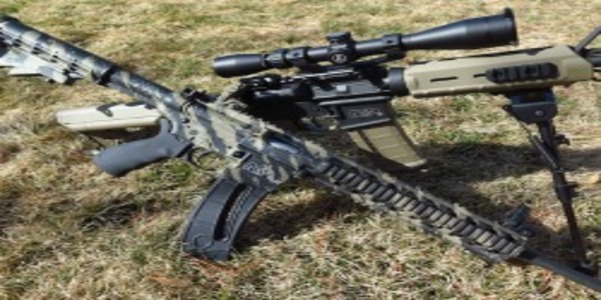There are many .22 long rifles worthy of consideration as the Last Best Plinker. In most cases, three categories of .22 rifles emerge when tossing them into piles according to similarities; those of classic variety with actions of lever, bolt, and tube-feed semi-auto. And there are those of the modern design with composite stocks, detachable box magazines, and aftermarket accessories. And then there is the Ruger 10/22, a classic design of modern or even epic proportions that everything else is compared to so it’s in a category all by itself.
By Doc Montana, a contributing author of Survival Cache and SHTFBlog
The Last Best Plinker
Smith & Wesson M&P 15-22 vs. Ruger 10/22
In this exploration, a lightly blinged Ruger 10/22 will go head-to-head with a fairly trick but almost stock Smith and Wesson M&P 15-22. Now this is not a shooting match since neither gun is known as a tack driver so their performance papers would be the same and likely more of a test of shooter skill or optics power than gun performance. For those who want pure accuracy, look towards the Savage or Marlin bolt action options. This challenge will be to consider the pros and cons of the 10/22 and the M&P 15-22 through the eyes of survivalism, training, and Everyday Bug Out Carry (EBC).
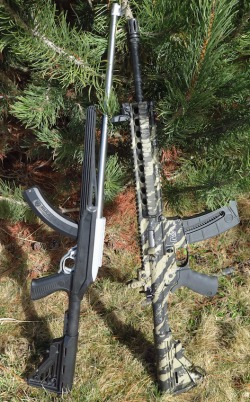
Now for anyone who thinks this is not a fair fight for some reason, the 10/22 first went on sale in 1964, and the first AR-15 changed hands for money five years earlier in 1959. Needless to say that the histories of these two rifle styles have had plenty of time to sort out their personal lives. I will admit, however, that the M&P 15-22 is still a kindergartener in its current AR iteration.
Action!
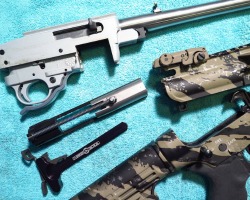 Both actions are spring-loaded blowback semi-autos. Both are proprietary designs. And both have stellar reputations for delivering the goods downrange when needed. Giving the nod to one gun over the other is a tough call since there is a 50 year history of reliability on Ruger’s side, but the AR simplicity for access and cleaning is on Smith’s side. In this case, I am leaning towards the M&P 15-22 just because tear down and cleaning of the Ruger action is not fun, nor something you ever enjoy doing in the field. In fact, you would think that in five decades of pumping out 10/22s, Ruger would have evolved the design to be more consumer-maintenance friendly since the ammo has not cleaned up its act still shooting dirty after all these years. Not to mention that it requires a couple tools to even access the innards. So I think the M&P 15-22 wins so far.
Both actions are spring-loaded blowback semi-autos. Both are proprietary designs. And both have stellar reputations for delivering the goods downrange when needed. Giving the nod to one gun over the other is a tough call since there is a 50 year history of reliability on Ruger’s side, but the AR simplicity for access and cleaning is on Smith’s side. In this case, I am leaning towards the M&P 15-22 just because tear down and cleaning of the Ruger action is not fun, nor something you ever enjoy doing in the field. In fact, you would think that in five decades of pumping out 10/22s, Ruger would have evolved the design to be more consumer-maintenance friendly since the ammo has not cleaned up its act still shooting dirty after all these years. Not to mention that it requires a couple tools to even access the innards. So I think the M&P 15-22 wins so far.
The charging handle on the M&P 15-22 is straight out of the ArmaLite playbook. In fact, the only thing you would notice at first pull compared to an AR15 is that the M&P 15-22 draws less than two inches compared with the three and a half inched on a full-sized AR. For that reason, first-time pullers will either over pull the handle stressing its plastic nature, or have the handle snap out of their grip and slam home just like it should.
Like Father Like Son
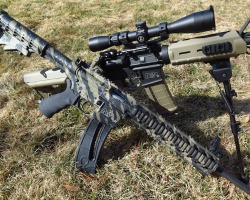 Like the AR15, the bolt on the 15-22 locks open on the last shot allowing faster and simpler reloads. However, a major oversight, in my opinion, was for Smith and Wesson to use a plastic (polymer?) charging handle. The thing is flimsy, and based upon a few reports of breakage, it seems too brittle to mimic an aluminum handle in such a critical part. In fact S&W even recommends in the fine print of the M&P 15-22 instruction manual to be gentle with it. Well, they do not quite say that outright, but read between the lines of “NOTE: Pull the charging handle by both sides uniformly.” What do you think? I cannot remember that particular request with my S&W M&P15, the AR that the M&P 15-22 copies, but when I dug through it’s instruction manual, sure enough there was the line buried in a block of text with no fanfare except parentheses. And I quote “(uniformly by both sides).”
Like the AR15, the bolt on the 15-22 locks open on the last shot allowing faster and simpler reloads. However, a major oversight, in my opinion, was for Smith and Wesson to use a plastic (polymer?) charging handle. The thing is flimsy, and based upon a few reports of breakage, it seems too brittle to mimic an aluminum handle in such a critical part. In fact S&W even recommends in the fine print of the M&P 15-22 instruction manual to be gentle with it. Well, they do not quite say that outright, but read between the lines of “NOTE: Pull the charging handle by both sides uniformly.” What do you think? I cannot remember that particular request with my S&W M&P15, the AR that the M&P 15-22 copies, but when I dug through it’s instruction manual, sure enough there was the line buried in a block of text with no fanfare except parentheses. And I quote “(uniformly by both sides).”
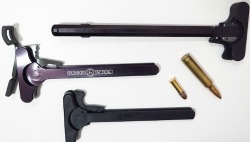 But you know, I did swap out all my AR charging handles as well for Raptors and Troys. So trading out the M&P 15-22’s plastic plunger for a Plinker Tactical ambidextrous aluminum one seemed obvious. Unfortunately the Plinker Tactical charging handle weighs 1.75 ounces or over half an ounce more than a real AR charging handle. Since the S&W plastic charging handle weighs only half an ounce, upgrading to the Plinker adds three times the OEM charging handle weight. In defense of the Plinker Tactical, it is an effective ambidextrous design leading to a more formal and satisfying pull and snap whether on right, left, or both sides.
But you know, I did swap out all my AR charging handles as well for Raptors and Troys. So trading out the M&P 15-22’s plastic plunger for a Plinker Tactical ambidextrous aluminum one seemed obvious. Unfortunately the Plinker Tactical charging handle weighs 1.75 ounces or over half an ounce more than a real AR charging handle. Since the S&W plastic charging handle weighs only half an ounce, upgrading to the Plinker adds three times the OEM charging handle weight. In defense of the Plinker Tactical, it is an effective ambidextrous design leading to a more formal and satisfying pull and snap whether on right, left, or both sides.
And it’s not that the Ruger is immune to “necessary” post-purchase upgrades as well. Until recently, right out-of-the-box the 10/22 was in serious need of a better mag release and an intuitive bolt hold-open lever. In this case, I prefer the 10/22’s design for moving a round into battery, but really it is splitting hairs.
Mags Not Clips
Neither gun has any great advantage over the other with magazines. Both .22s take proprietary magazines with 10 or 25 round capacity. Both have aftermarket options of similar and larger capacity. And the prices of extra mags are within a few bucks of each other. If cornered, I have to give the nod to the 10/22 in this case for one simple reason. The M&P 15-22 mag mimics the size and shape of the standard AR 30 round mag. This means that some of the design elements of the M&P 15-22 mag are not optimized for .22 LR performance but instead to ape a real AR box. On the other hand…When it comes to the actual magazine operation, I prefer the Smith and Wesson for it’s ease of loading, simple disassembly and cleaning, ability to occupy traditional AR mag storage solutions, and use aftermarket mag accessories such as the GRIPP Magtab made by NDZ Performance (similar to a Magpul Ranger Plate). Or heck, just use the original Magpul Magpul.
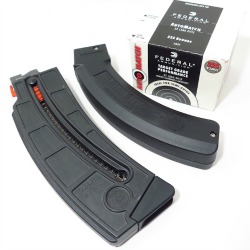
The 10 round Ruger rotary mag is a bomb-proof piece of hardware, but cleaning is a bear, and loading it is slow. And the 25 round Ruger BX-25 is even worse. At almost an ounce heavier than the 25 round Smith mag (6.4 oz for the Ruger and 5.6 oz for the Smith), the Ruger also takes a 3/32” hex head wrench to remove the three screws allowing access to the spring and follower. The Smith mag takes a bullet tip just like a polymer AR mag. However, the exposed spring on the Smith is vastly more likely to muddy-up than the heavily enclosed BX-25 spring.
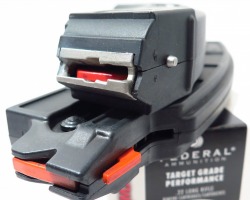
Trigger Point
Often a better question to ask when comparing factory triggers is not which one is nicer, but rather which one sucks less. But in his case the stock triggers on these two guns are a wash. Neither is all that great, but then again, neither is a real problem. Both triggers are as smooth as an arthritic knee, and weigh about the same. While the 15-22’s bolt carrier group might be from another planet compared to the AR15 platform, the trigger group of the M&P 15-22 is 100% interchangeable with traditional and drop-in AR triggers.
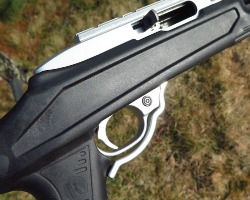
Aftermarket triggers for the Ruger are available, but enter a financial rabbit hole I managed to avoid thus far. But again, since neither rifle is designed for ultimate accuracy, both triggers are close enough but if I had to choose a winner out of the box it would be the M&P 15-22.
Taking Stock
The Ruger 10/22 definitely wins the stock options debate mostly because the action is removable from the stock while the lower receiver on the Smith limits the stock choices at point of purchase. In fact, the main differences between the various M&P 15-22 models mostly involves the stock, whether by color or brand. Magpul is on the bandwagon with its adjustable stocks and pistol grips, but in reality that is only because of the M&P 15-22/AR15 interchangeability. So I guess if you consider being stuck in the world of adjustable AR stocks as a good thing, the M&P 15-22 might win this. But if you want to completely change the stock design from adjustable, to target, to conventional, to folding, then Ruger wins.
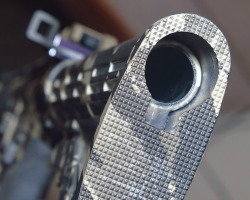
The durability of a fixed stock over a folding or sliding one is the same consideration as comparing fixed and folding knives. It is a matter of quality and use. If you need the stock to bash in the heads of zombies, I’d suggest a stout hardwood. But if you are going to carry the gun for miles on end, in all weather, with little concern for anything gentle, then a composite or polymer stock is the best. Plus it fits a range of users from child to adult. In fact, in the non-zombie world, the only advantage wood has over synthetic, in my opinion, is that you are always carrying around a chunk of firewood. Think about it. You could make quite a few feather sticks from your wood stock before it snaps in half when the gun is fired, but it will likely break under it’s own weight before the recoil of a .22 would make a difference.
Also Read: Ruger 10/22 Takedown Review
In the end, I really prefer a modern adjustable AR-type stock for general purpose rifles. Traditional stocks have their place and will always win durability contests, but as a Last Best Plinker, I am giving the nod to the M&P 15-22 compared to off-the-shelf 10/22’s. Plus, for those of you who like to squirrel away supplies in any available nook or cranny of your rifle stock, the M&P 15-22 has no buffer spring but does have a buffer tube. Instead of wasting the space, Smith and Wesson offer it up to the user through a rubber cap countersunk into the rifle butt. And it’s a hole plenty big enough to mention.
Unfortunately, the composite stock Ruger has no access to it’s a air-filled interior. I would gladly pay an extra $20 or $30 for a nice access port into the voluminous buttstock of the 10/22 in case Ruger or any aftermarketeers are reading this.
Forethought
The forend of the classic Ruger 10/22 has always been a disappointment to me. The barrel band is the antithesis of a floating barrel, and the utter lack of attachment points make a traditional 10/22 a questionable modern survival rifle. If the cost of a 10/22 hovered around a hundred bucks, I could forgive the design, but since the street price is two or three times higher, I expect a little more modernization.
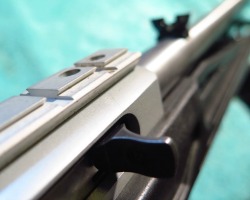
The handguard on the M&P 15-22 is a non-easily (if at all) interchangeable polymer quad-rail. While it looks and acts just like its metal counterparts, the plastic feel and potential durability (or lack of) makes me think twice about attaching any major-stress appliances like a QD adapter. There is a subtle but noticeable flex in the handguard when you add an accessory that gives you a longer lever arm like a vertical grip or bipod. But remember the upper receiver, the lower receiver, the stock, and the handguard are all plastic (or polymer or composite or high-tech or whatever you want to call it) so being lightweight is the positive tradeoff.
I guess the question is whether a wimpyish quad rail is worse than no rails at all. Of course there are many beefier stock options for the 10/22 that mimic the strength of an AR15 rail while not necessarily looking like one. The mission in life for the Smith, on the other hand, is to look, feel, and behave like a real AR15. Either way, the nod has to go to the M&P 15-22 because the Ruger has no real options to compare except that it keeps your palm off the barrel. Unless, of course, you do the aftermarket dance as I have, or go with one of the newer tactical 10/22 options Ruger is building.
What’s In Sight?
The basic M&P 15-22 comes with heavy steel and aluminum iron sites. So dumping the OEM sights not only instantly drops 7.3 ounces of dead weight, but also frees up the top rail for something much better than old-school irons that requires the same A2 front sight tool as grandpa’s AR.
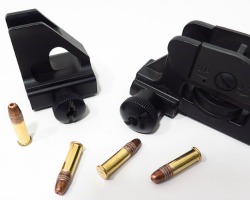
Losing weight is only half the picture. The M&P 15-22 is specifically designed to mirror the AR15’s operation, but not the AR’s weight. To make the M&P 15-22 feel more like an full-grown AR15, you would need to add a couple or three pounds to the Smith. In addition to leaving the heavy sights in place, and bolting on a little bling, some have suggested adding lead shot to the pistol grip. For my use, I chose the lighter side of the coin and dumped the factory sights replacing them with Magpul Gen2 MBUS polymer sights, an FDE rear and a black front.
The 10/22 is as traditional as it gets. Dovetails rule and low profile is the only choice. Most 10/22s ship with a section of rail that can be attached to the top of the receiver allowing a glass optic to be mounted, but then the factory sights are blocked unless you remove the rail. I consider this a no-brainer. The M&P 15-22 wins.
Weight For Me!
Probably the most intoxicating feature of the M&P 15-22 is its weight, or rather lack of compared to an AR15. The M&P 15-22 weighs in at about 5 lbs, 5 oz with an empty 25 round mag. Drop the mag and you have a 4 lb 15 oz rifle. Swap out the factory peepers for the Magpul sights and you drop another five ounces. So at 4 lbs 10 oz you are roughly half the weight of a lightly accessorized AR15.
An average Ruger 10/22 weighs in about 5 lbs out of the box with no mag. The only way to drop more weight is to swap out major parts. If you want to go crazy, you can get a 10/22 into sub-4 lb territory (or 3 lbs plus if you’re a glass half-full kind of person), but by that point there will be very little Ruger anything on the gun, and a price well north of $700.
Also Read: 7 Ruger 10/22 Accessories You Need
Given all the weight variables, and that both rifles are lightweight by any standard, this is a tie. However, as you add accessories to the 10/22, you will also need to add in the weight of the needed attachment points assuming you can even find the right connector outside gunsmithing it. So having a quad of rails handy is a distinct advantage that should not be considered part of the tie.
Cost of Sending Goods Downrange
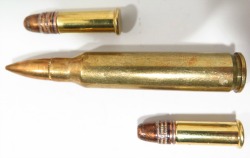 On a good day, the price of .22 ammo is about $20 per 500 rounds ($40/1000), or four cents per bang. The price of .223 runs around $399/1000 or forty cents per bang. In other words, an AR15 is 10 times more expensive to shoot than a .22. Of course your mileage may vary. But if we carry this further, you save about $360 per thousand rounds shot meaning that that the M&P 15-22 would pay for itself in AR training experience by about your 1400th trigger pull.
On a good day, the price of .22 ammo is about $20 per 500 rounds ($40/1000), or four cents per bang. The price of .223 runs around $399/1000 or forty cents per bang. In other words, an AR15 is 10 times more expensive to shoot than a .22. Of course your mileage may vary. But if we carry this further, you save about $360 per thousand rounds shot meaning that that the M&P 15-22 would pay for itself in AR training experience by about your 1400th trigger pull.
The Ruger 10/22, on the other hand, would offer the same bangs per penny as the M&P 15-22, but with none of the muscle memory AR advantages. Of course if an AR15 is not on your list today, then the choice between the two will be based upon other variables which might include the inverse decision of avoiding the M&P 15-22 at all costs specifically because it does look like an AR15.
A Second Opinion
There is another side to this story in that the M&P 15-22 is not the only player in the .22 LR AR space. HK makes a .22 copy of their AR-like carbine named the 416, Colt farmed out an AR “replica,” and there are some popular conversion kits to turn your favorite (or least favorite) AR into a .22 LR masterpiece.
There are, however, some significant problems with the aforementioned AR-22 options. With the HK, the list is easy. The HK has a fake bolt release paddle, a fake forward assist, a fake gas block, different length receiver pins which are non-retaining, disassembly not recommended by the company, a sleeved ⅓ inch outer-diameter actual barrel with a non-standard muzzle thread, is heavy like the big brother it’s seems jealous of, it’s expensive, and the final coffin nail– it’s not made by HK. Instead it’s subcontracted to Walther and Umarex, a big name in the Airsoft world.
Also Read: SHTF Firearm Choices
The Colt is not much better. Colt’s offering in this class looks and hefts like a real AR15/M16, but that’s about where it ends. In addition to a fake forward assist, and dysfunctional dust cover, the pistol grip, stock and trigger are proprietary, the barrel is a shrouded pencil like the HK, and the bolt is a total one-off that is not to be removed or serviced by the user. Plus the bolt closes on the last shot. Oh yes, and there is the same Walther/Umarex subcontracting.
On the conversion side, well, the first clue might be the word conversion. Whenever you have to convert something into something else, you will suffer design problems by having to conquer the shortcomings of the starting point. In the case of an AR15 converted to an AR22, the obvious targets are the cost (an AR plus the conversion kit), .22 LR specific magazines, and that the .22 LR must be shot out of a 5.56mm barrel diameter. Not really a problem unless you’re a fan of accuracy. The bore diameter might be close enough, but the twist is off by more than a factor of two (5.56 @ 1 in 7 and .22 LR @ 1 in 16, and the M&P 15-22 has a 1 in 15 twist). Further, a zeroed sight is not interchangeable between the two bullets. About the only way to combat this conversion conundrum is to go with an expensive dedicated AR .22 upper with its own sights or optic. That will solve some of the problems, but adds even more expense. And either way, the .22 LR is a notoriously filthy cartridge so your precious AR15 will get all dirtied up when enjoying the benefits of the smaller cheaper round.
Related:SHTF Armorer: The AR-15 Bolt Carrier Group
Final Curtain or Encore?
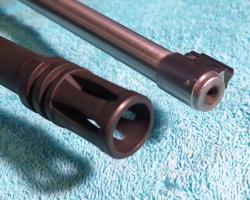 In the end, a .22 rifle dedicated to mimicking the venerable AR15 is an excellent option for training new shooters, and for inexpensive practice with experienced shooters, and just a darn fine reliable .22 rifle that is much quieter than a centerfire AR as well as having negligible muzzle blast. But the benefits of such a beast are weighted heavily towards the AR-side over the .22 side which might be a highly desirable standardization on its own.
In the end, a .22 rifle dedicated to mimicking the venerable AR15 is an excellent option for training new shooters, and for inexpensive practice with experienced shooters, and just a darn fine reliable .22 rifle that is much quieter than a centerfire AR as well as having negligible muzzle blast. But the benefits of such a beast are weighted heavily towards the AR-side over the .22 side which might be a highly desirable standardization on its own.
The Ruger 10/22, on the other hand is a proven design that in spite of the takedown/cleaning issues, this dedicated .22 platform has plenty of self-confidence and couldn’t care less about the other guns in the safe. Since a .22 LR is an absolute must for anyone with a clue, the real question when deciding between the Ruger 10/22 and the Smith and Wesson M&P15-22 is not which gun you will buy, but rather which gun you will buy first.
by Doc Montana

